Recently, the Department of Culture and Tourism of Guangdong Province released four archaeological trails in Guangdong. You could follow in the footsteps of history and culture by visiting Guangdong during the May Day holiday!
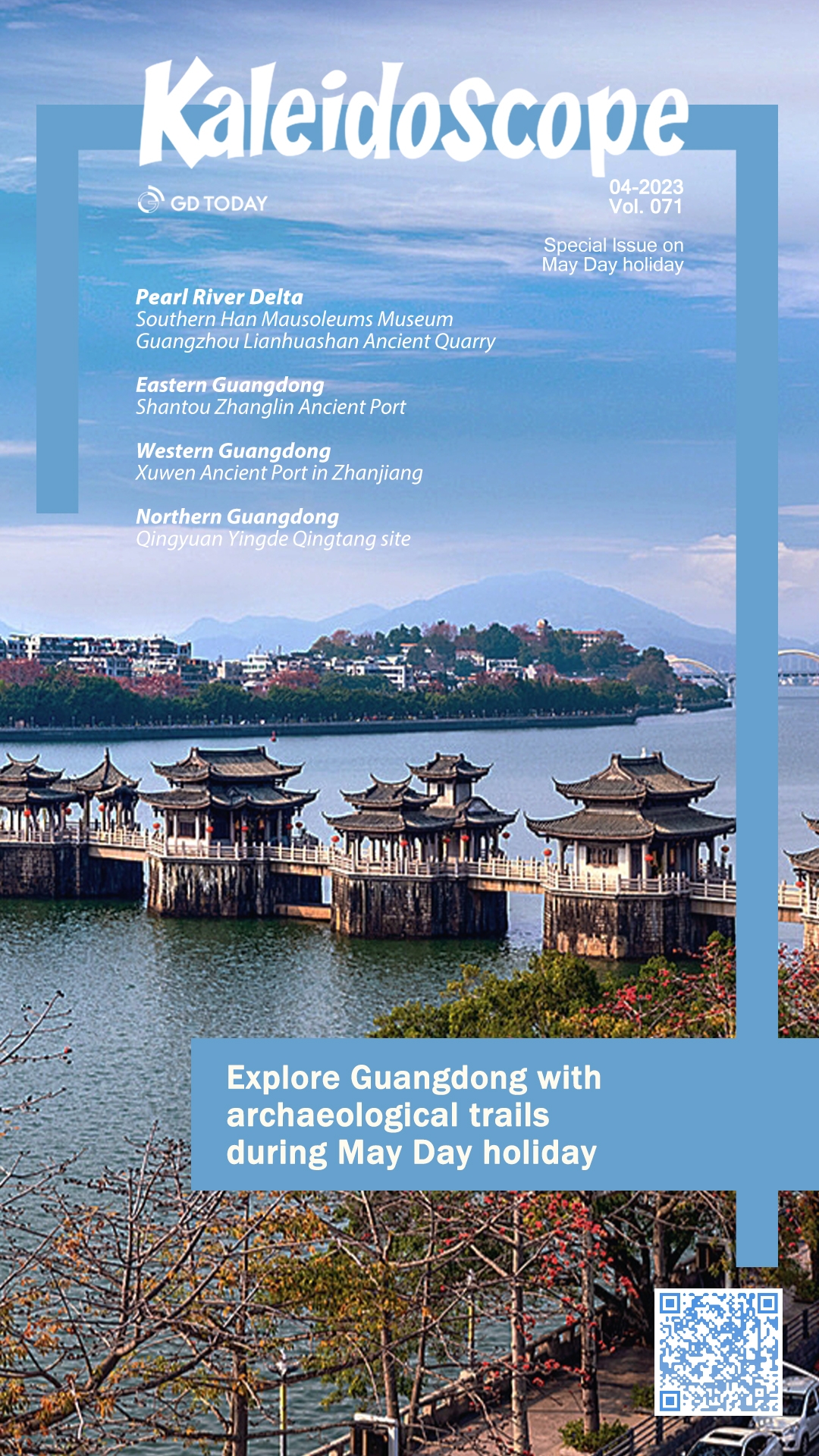
1. Pearl River Delta Archaeological Trail
Haogang Site Museum of Dongguan - Guangzhou Lianhuashan Ancient Quarry - Foshan Xiqiao Mountain Shiyanyan Quarry - Historic Site of Nanyue Kingdom Palace - Archaeological Site of the Wooden Water Gate of Nanyue Kingdom - The Site of Nanyue King’s Tomb - The sites of the Millennium Ancient Road on Beijing Road - Southern Han Mausoleums Museum - Guangzhou Nanhai Temple - Guangzhou Huangpu Ancient Port - Guangzhou Nanshitou Prison Site
东莞蚝岗遗址——广州莲花山古采石场——佛山西樵山石燕岩采石场——广州南越国宫署遗址——广州南越国木构水闸遗址——广州西汉南越王墓——广州北京路千年古道遗址——广州南汉二陵博物馆——广州南海神庙——广州黄埔古港——广州南石头监狱旧址
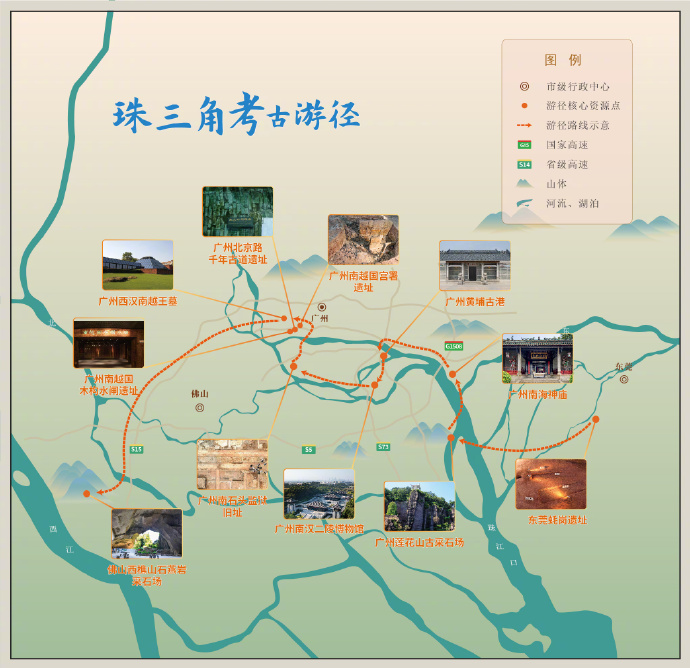
Introduction of some scenic spots
Historic Site of Nanyue Kingdom Palace
The Site of Palace and Garden centers on the Historic Site of Nanyue Kingdom Palace, containing 13 cultural strata from the Qin dynasty to the Republic of China. The royal garden of Nanyue, consisting of a large stone pond discovered in 1995 and a crooked stone brook discovered in 1997, is the earliest and the best preserved royal garden found so far in China.
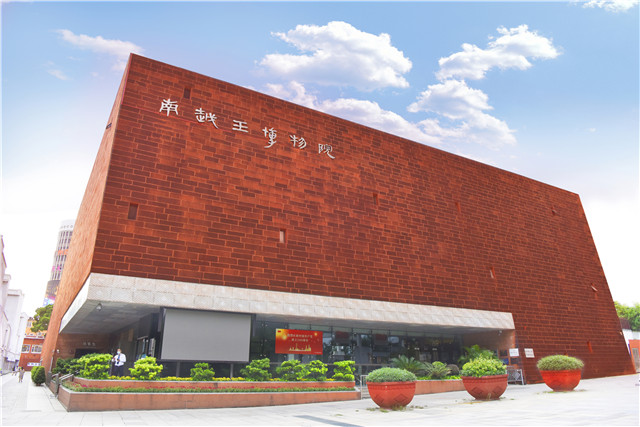
The Site of Nanyue King's Tomb
The Site of King’s Tomb centers on the Tomb of the Nanyue King Wen, which was discovered in 1983. This tomb is the highest-grade, largest, and best-preserved painted stone tomb of the Han Dynasty in the Lingnan region. More than 1,000 pieces (sets) of cultural relics have been unearthed from the tomb, among which the Gold Administrative Seal of Emperor Wen, a jade drinking vessel in a rhinoceros horn shape, and a jade burial suit sewn with silk thread of great historical value. The site is called “The Glory of Lingnan”.
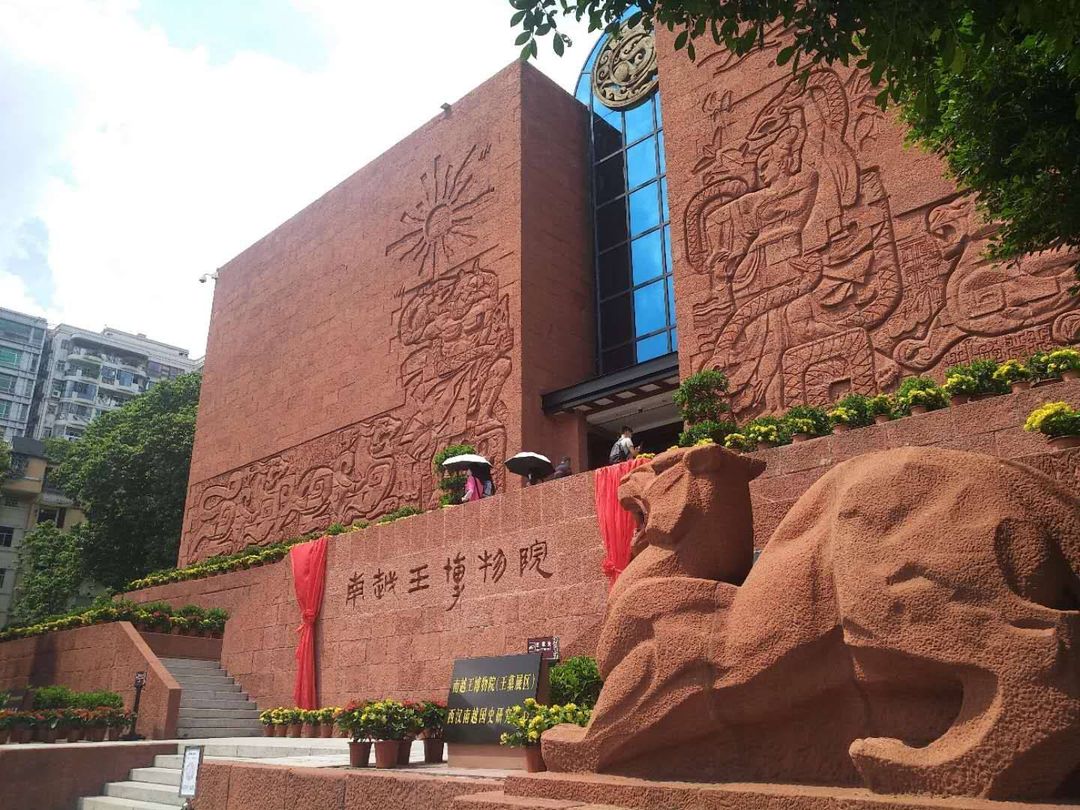
Southern Han Mausoleums Museum
Situated at the hillside Relic Park in the Guangzhou Higher Education Mega Center in Panyu District, the museum is designed to better protect the Jangling Mausoleum and display the unearthed cultural relics. It is built on the sites of tombs of two monarchs of the Southern Han Dynasty during the Five Dynasties and Ten Kingdoms period. In terms of planning, the museum refers to the architectural layout of the TANG Dynasty and organizes the three courtyards, sunken courtyards, corridors, and tile ridges in a symmetrical way.
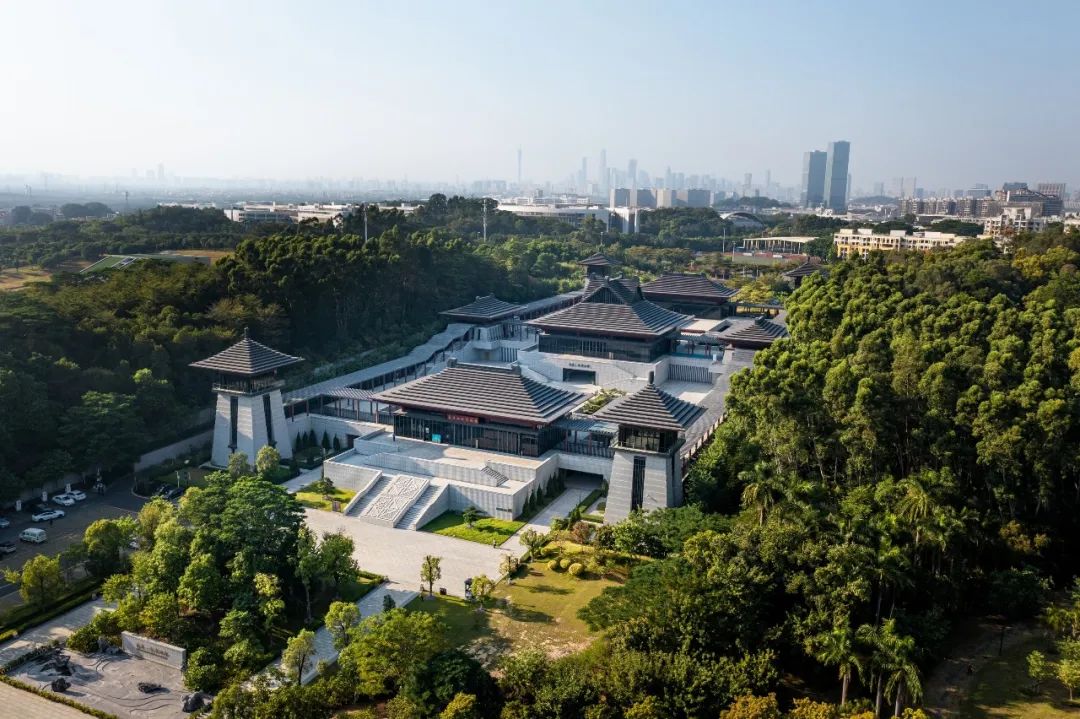
Huangpu Ancient Port
Huangpu Ancient Port is located in the Huangpu Village, Haizhu District, Guangzhou. During the Southern Song Dynasty, it was an important port on the Maritime Silk Road. During the period from mid-1700 to mid-1800, thousands of ships would have docked here for international trade. It was rebuilt after the visit of the antique merchant ship Gothenburg in 2006.
Guangzhou Nanshitou Prison site
Guangzhou Nanshitou Prison site was originally the site of the Zhennan Fortress in the late Qing Dynasty. In the second year of the Republic of China (1913), the fortress was transformed into a prison. The archaeological excavation at this site between 2021 and 2022 unveiled a series of significant ruins such as the walls of Zhennan Fortress, the prison cells of Nanshitou Prison as well as unearthed relics including shackles, bullet shells, and reagent bottles.
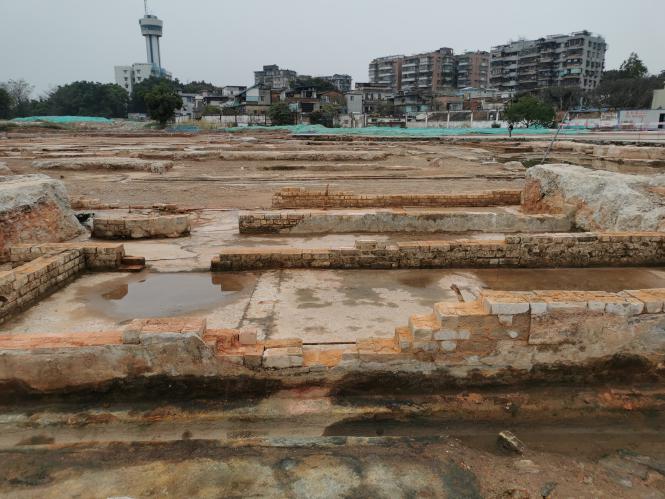
2. Eastern Guangdong Archaeological Trail
Bijiashan Chaozhou Kiln Ruins - Chaozhou Guangji Bridge - Shantou Zhanglin Ancient Port - Nan'ao No. 1 (Museum of Coast Defence History in Nanao County)
潮州笔架山潮州窑遗址——潮州广济桥——汕头樟林古港——“南澳Ⅰ号”(南澳海防史博物馆)
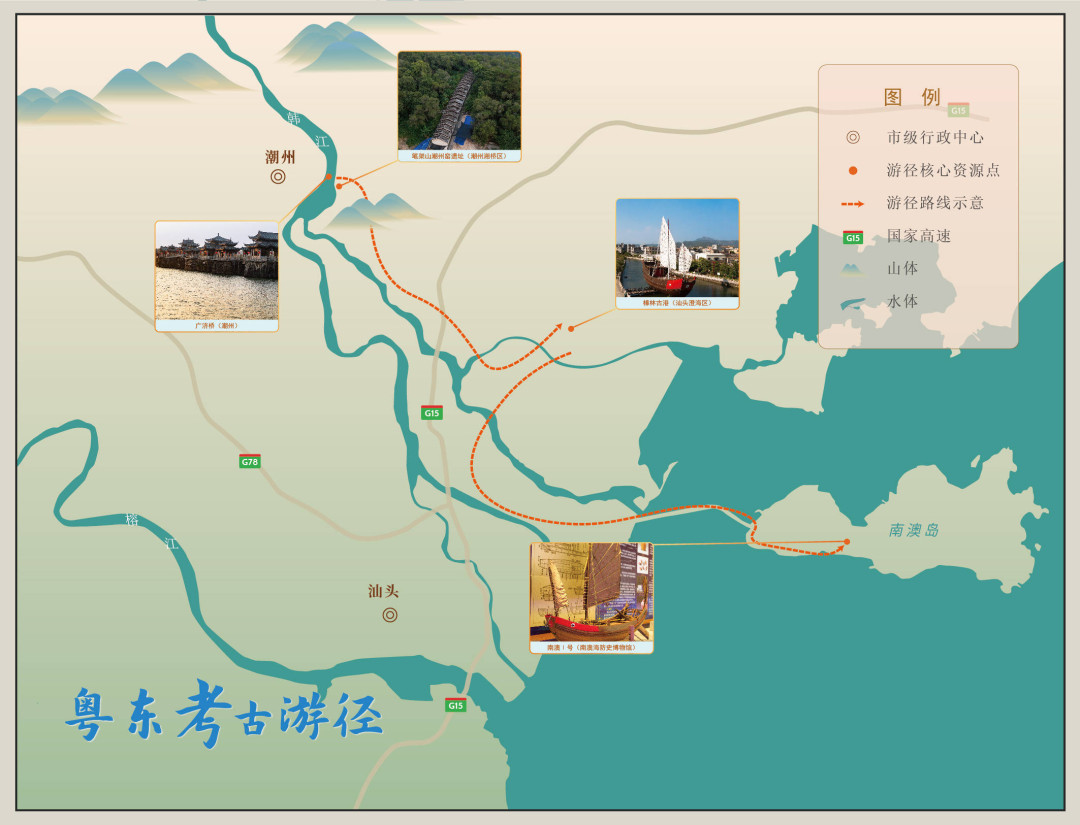
Introduction of some scenic spots
Bijiashan Chaozhou Kiln Ruins
Bijiashan Chaozhou Kiln site is located at the western foot of Bijiashan on the east bank of the Hanjiang River. During the Northern Song Dynasty, skilled craftsmen in Chaozhou produced a large number of high-quality and novel porcelain wares based on techniques of other excellent kilns, such as Jingdezhen, which made Bijiashan Kiln one of the most important kilns along the southeast coast of China. According to legend, there were ninety-nine kilns here, known as "Hundred Kiln Village". It is also one of the important places of the Maritime Silk Road.
Chaozhou Guangji Bridge
Guangji Bridge, also known as Xiangzi Bridge, is an ancient bridge that crosses the Han River east of Chaozhou, Guangdong. As a key cultural relic, the bridge is renowned as one of China's four famous ancient bridges, the other three being Zhaozhou Bridge, Lugou Bridge, and Luoyang Bridge. With a total length of 518 meters, Guangji Bridge is the only bridge in China that integrates a girder bridge, an arch bridge, and a pontoon bridge.

Shantou Zhanglin Ancient Port
Zhanglin Ancient Port is located in Dongli Town, Chenghai District, Shantou. Since the Ming Dynasty, it has been a lively seafood port. Beginning in 1722, Chinese merchants began to trade rice with Thailand, and Zhanglin's ocean-going voyages also developed. Its routes lead to Suzhou and Tianjin in the north, and to Thailand, Indonesia, Malaysia, and other countries in the south.
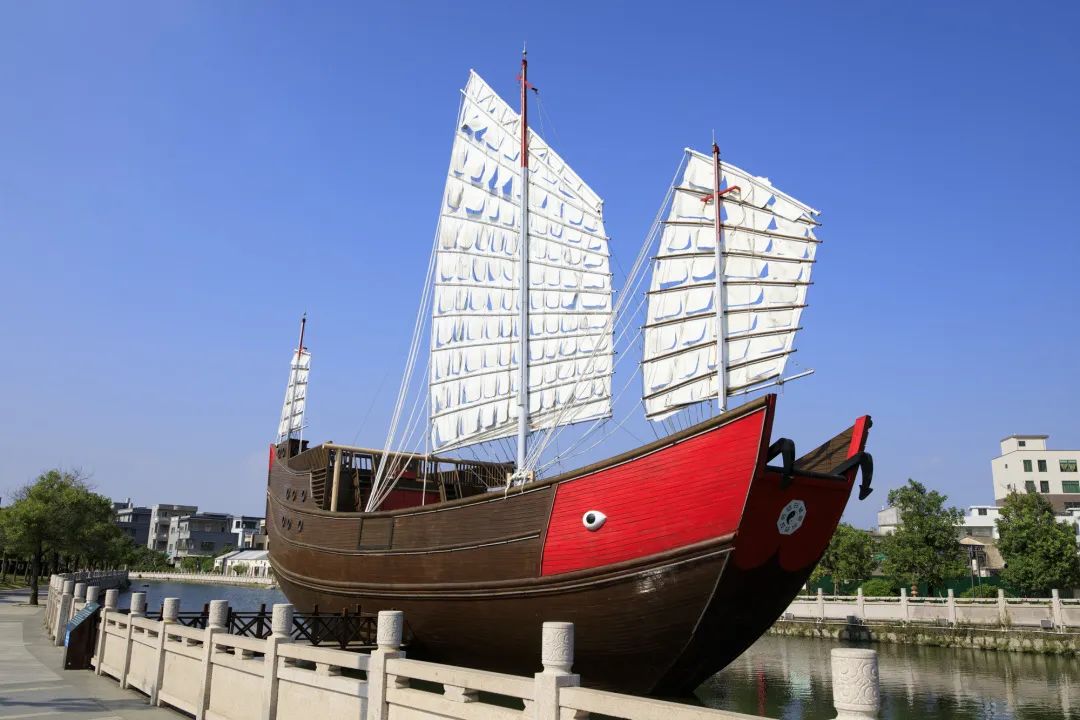
Nan'ao No. 1 (Museum of Coast Defence History in Nanao County)
The shipwreck of Nan’ao No. 1 was discovered near Nan’ao Island off the coast of Shantou City in Guangdong. In its hull, over twenty thousand artifacts were discovered, as well as soil samples, metal samples, and remains of animals and plants were also recovered.
As one of the Great 10 National Archaeological New Finds of 2010, the Nan'ao No. 1 project has been singled out as being of special importance for the research of foreign trades in the late Ming Dynasty, on the Maritime Silk Road, as well as a successful exercise of the development and practice of underwater archaeology in China. It greatly raises public awareness of underwater cultural heritage.
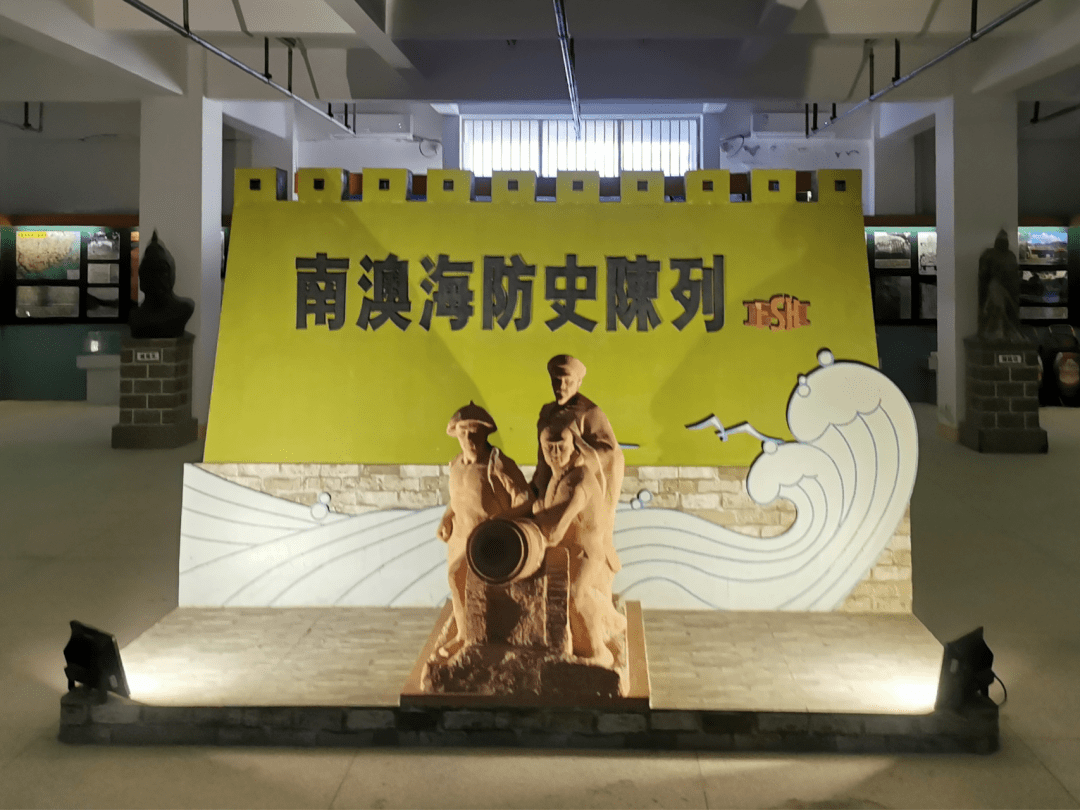
3. Western Guangdong Archaeological Trail
Taishan Dazhou Bay Ruin - "Nanhai No. 1" (Guangdong Maritime Silk Road Museum) - Tomb of Lady Xian, aka Lady of Qiaoguo in the Sui Dynasty, Maoming - Xuwen Ancient Port in Zhanjiang
江门上川岛大洲湾遗址——“南海Ⅰ号”(广东海上丝绸之路博物馆)——茂名隋谯国夫人冼氏墓——湛江徐闻古港
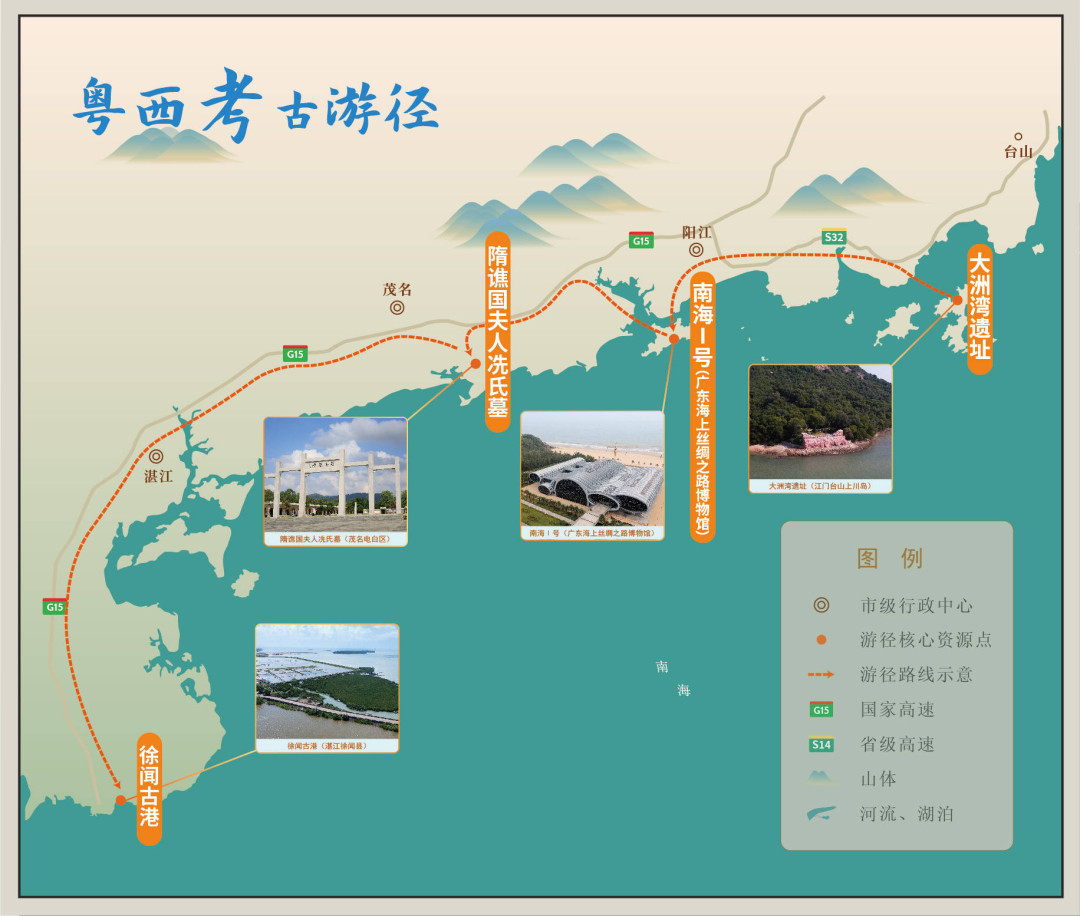
Introduction of some scenic spots
Taishan Dazhou Bay Ruin
Taishan Dazhou Bay Ruin in Jiangmen, Guangdong, originally worked as the site of the porcelain exporting trade between China and Portugal in the Ming Dynasty. The unearthed relics are mainly blue and white porcelains, which used to be exported in trade activities between the two countries at that time.
"Nanhai No. 1" (Guangdong Maritime Silk Road Museum)
The Nanhai No. 1 shipwreck, 30m long and 10m wide, discovered 25m under the sea in 1987, is believed to have been built between 1127 and 1279 AD during the reign of the Southern Song Dynasty.
After the integral recovery in 2007, the wreck of Nanhai No. 1 is now preserved in the Guangdong Maritime Silk Road Museum, where it has been placed in an aquarium. Excavations in this semi-submerged aquarium environment are now ongoing and some 60,000 pieces, primarily porcelains from the Jingdezhen kiln, Dehua kiln, Cizao kiln, and Longquan kiln, wood wares, iron wares, copper coins, copper rings, and lacquer chips have already been recovered.
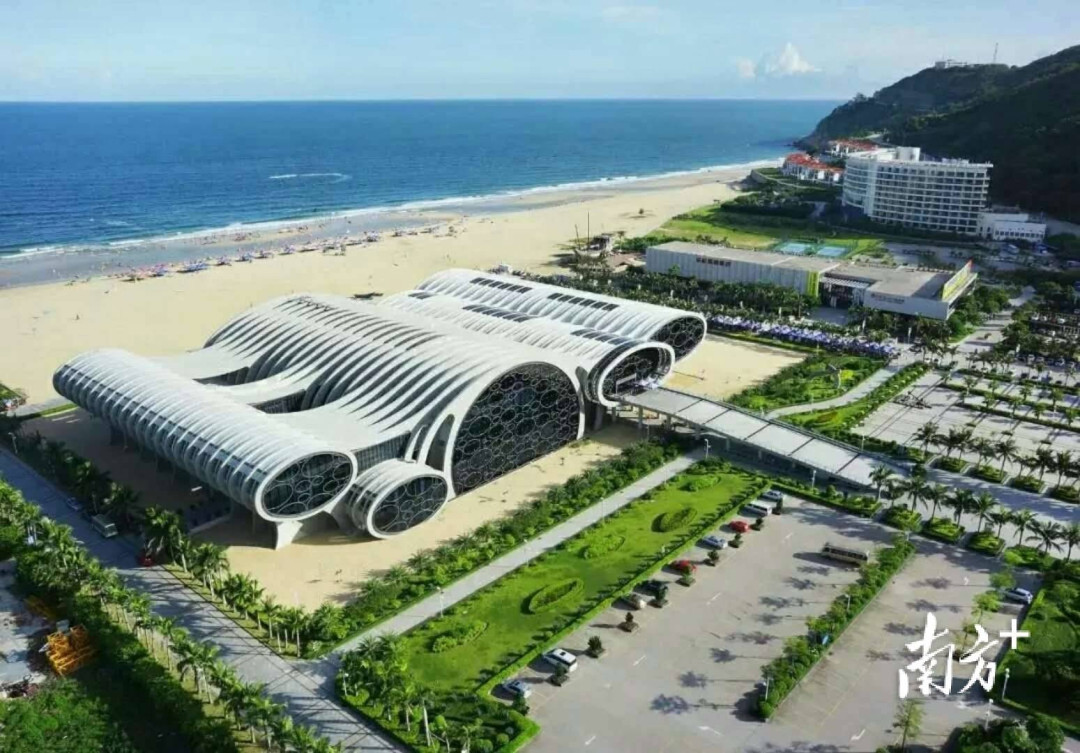
Xuwen Ancient Port, Zhanjiang
The former site of Xuwen Ancient Port is located in Xuwen County, Zhanjiang City, Guangdong Province. Xuwen Ancient Port is the world's first port of departure for the Maritime Silk Road with official historical records. The Maritime Silk Road route with Xuwen Port as the starting port is also the earliest and longest Maritime Silk Road route recorded in the history of maritime transportation between China and the West.
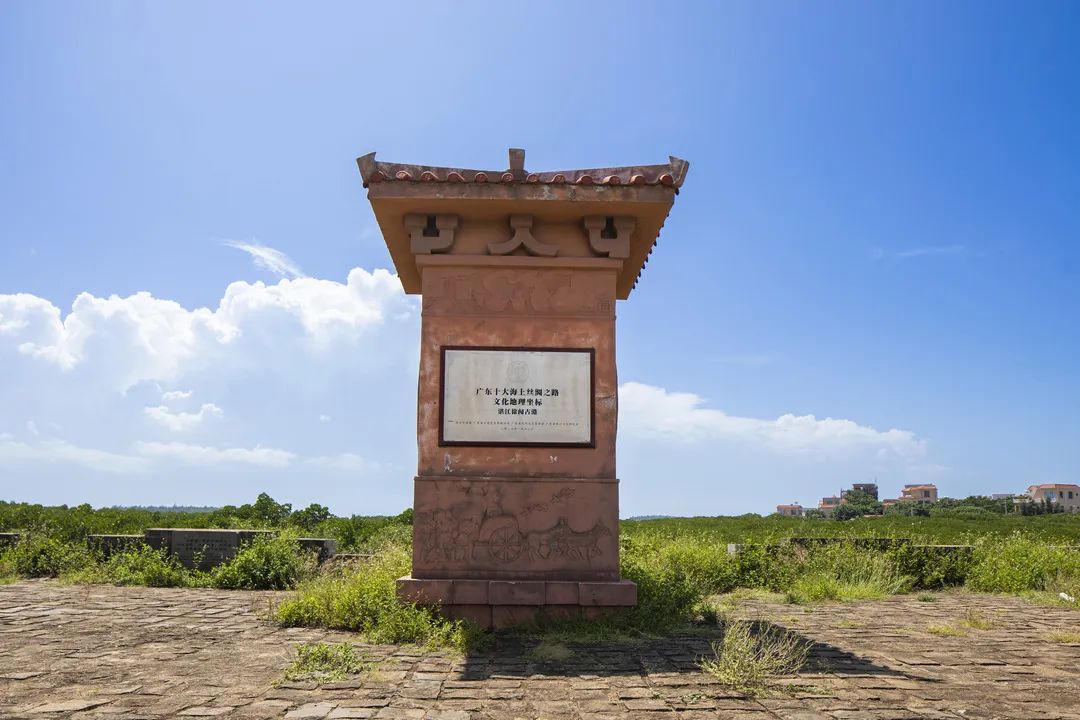
4. Northern Guangdong Archaeological Trail:
Yunan Modaoshan site - Qingyuan Yingde Qingtang site - Yingde Yanshanzhai site - Shaoguan Shixia site - Shaoguan Maba Man Ruins
云浮郁南磨刀山遗址——清远英德青塘遗址——清远英德岩山寨遗址——韶关石峡遗址——韶关马坝人遗址

Introduction of some scenic spots
Yunan Modaoshan site
Yunan Modaoshan site is located in Hedu Village, Hekou Town, Yunan County, Yunfu City. The Modaoshan Site is the first open site of the Paleolithic Age scientifically excavated in Guangdong Province and the earliest cultural remains of the early human beings in Guangdong Province confirmed to date.
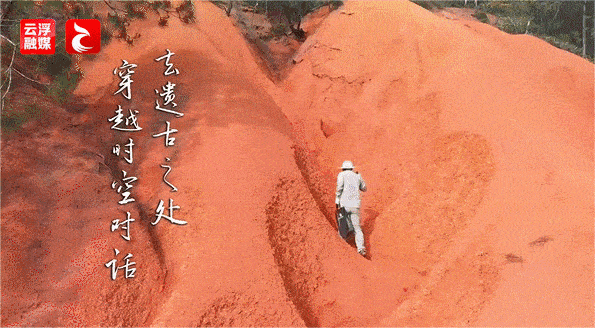
Yingde Qingtang site
Yingde Qingtang site covers a variety of caves as well as many important ruins such as tombs and ancient Chinese fireplaces. More than 10,000 pieces of cultural relic samples were unearthed, including Guangdong's oldest potteries, fossils of ancient humans, stone-made artifacts, mussel-made artifacts, animal bones, and vegetal remains, establishing a continuous stratigraphic and cultural sequence dating back from about 25,000 to 10,000 years ago.

Yingde Yanshanzhai site
In the Yingde Yanshanzhai site, nearly 2,000 pieces of cultural relic samples of all kinds were unearthed, including potteries, stone-made artifacts, jade wares, bronze wares, human bones as well as some wooden remains. Importantly, archaeologists have discovered 76 tombs of the late Neolithic period at the site, so their location can be considered to be a cluster of ancient tombs. The Yingde Yanshanzhai site is known as the largest ancient settlement in the Lingnan region dating back from the Neolithic period to Xia and Shang Dynasties.
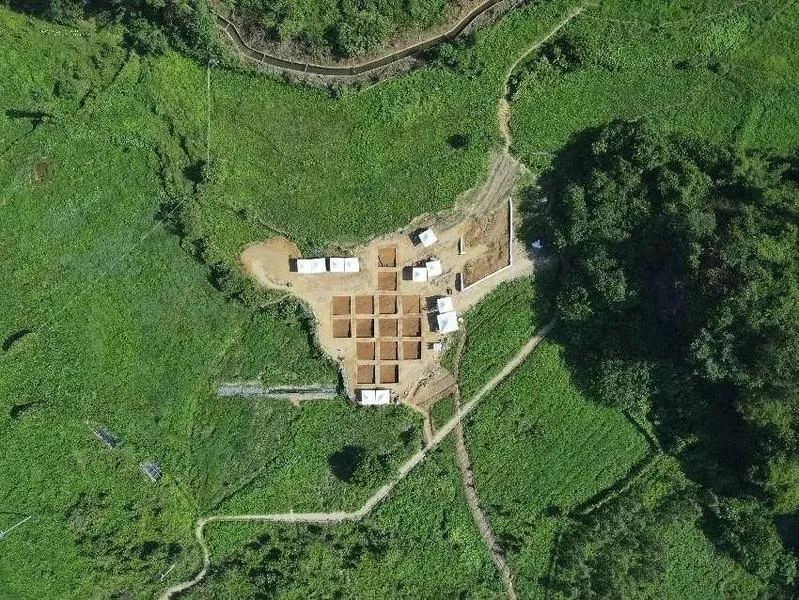
Shaoguan Shixia site
A site that overlaps chronologically both Hemudu and the southwest Guangxi Shell Middens is in northern Guangdong at Shixia. This site has three strata corresponding to the Western Zhou to Spring and Autumn period, Xia and Shang, and the late Neolithic Age. Shixia is far closer to Hemudu in its richness than the Guangxi Shell Middens, and seemingly is tied to the late Neolithic cultures of the middle and lower Yangtze regions.
Shixia Site covers about 30,000 square meters. So far, foundations of ancient houses, storage pits, pottery kilns, and tombs have been discovered at the site and about 3,000 pieces of stoneware, pottery, bone ware, and jade were unearthed.

Author | Alice
Editor | Olivia, Nan, Steven, Monica, Jerry
















